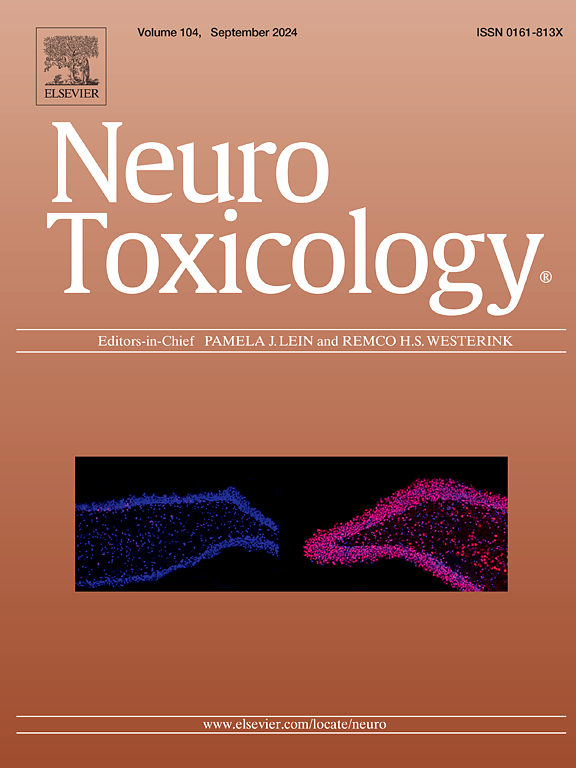Effects of daily exposure to pyrethroid pesticides during infancy on children neurodevelopment at age four: A prospective study in rural Yunnan, China
IF 3.9
3区 医学
Q2 NEUROSCIENCES
引用次数: 0
Abstract
Introduction
Exposure to pyrethroid pesticides (PYRs) of children in infancy at ages 1 and 2 may affect their neurodevelopmental outcomes at age 4.
Objectives
The study aimed to explore the longitudinal association of infancy PYRs exposure with neurodevelopment at age 4.
Methods
This study based on Xuanwei birth cohort study that started from January 2016 in rural Yunnan, China. Urine samples (n = 263) at ages 1 and 2 were tested for PYRs metabolites 3-phenoxybenzoic acid (3-PBA), 4-fluoro-3-phenoxybenzoic acid (4-F-3-PBA), and cis-3-(2,2-dibromovinyl)-2,2-dimethylcyclopropane-1-carboxylic acid (DBCA). PYRs metabolites were classified as low and high exposure using the 75th percentile values. Neurodevelopment of children aged 4 was assessed by Griffiths Development Scales-Chinese Edition (GDS-C). The development quotient below 85 was defined as low development level. Multiple linear regression and logistic regression were used to analyze the association of children’s PYRs exposure with their neurodevelopmental outcomes.
Results
Children’s PYRs metabolites detection rates were 98.48 % in infants at both age 1 and 2. The average levels of 3-PBA, 4-F-3-PBA and DBCA were 0.51 µg/L, 0.30 µg/L and < 0.09 µg/L, respectively at age 1; and 0.88 µg/L, 0.82 µg/L, and 0.52 µg/L at age 2. The levels of three metabolites in 2-year-olds were higher than those in 1-year-olds. The children aged 4 had a general developmental quotient of 90.87 ± 11.37, with 28.14 % classified in low development level. Multiple linear regression analysis showed that higher 3-PBA level at 2-year-old was negatively associated with the quotient in locomotor (β=-14.61, 95 % CI: −24.93, −4.30) and language (β=-10.89, 95 % CI: −19.38, −2.41). Logistic regression displayed that higher 3-PBA level aged 2 was positively correlated with low development level in the language domain (OR=3.23, 95 % CI: 1.33, 7.83), but negatively correlated with personal social domain (OR=0.23, 95 % CI: 0.07, 0.79).
Conclusion
Children were widely exposed to PYRs in infancy, which may impact on their neurodevelopment at age 4. Age 2 may be a sensitive window when PYRs exposure may negatively impact locomotor and language development. This study suggests that PYRs exposure should be minimized or avoided in child care, especially in children aged 2 years.
婴儿期每天接触拟除虫菊酯农药对儿童四岁时神经发育的影响:一项在中国云南农村地区进行的前瞻性研究。
1岁和2岁婴幼儿接触拟除虫菊酯杀虫剂(PYRs)可能会影响他们4岁时的神经发育结果。目的:本研究旨在探讨婴儿pyr暴露与4岁时神经发育的纵向关系。方法:本研究基于2016年1月开始的中国云南农村宣威出生队列研究。对1岁和2岁儿童的尿液样本(n=263)进行PYRs代谢物3-苯氧苯甲酸(3-PBA)、4-氟-3-苯氧苯甲酸(4-F-3-PBA)和顺式-3-(2,2-二溴movinyl)-2,2-二甲基环丙烷-1-羧酸(DBCA)的检测。使用第75个百分位值将PYRs代谢物分为低暴露和高暴露。采用格里菲斯发育量表-中文版(GDS-C)对4岁儿童的神经发育进行评估。发展商低于85为低发展水平。采用多元线性回归和逻辑回归分析儿童接触pyr与神经发育结局的关系。结果:1、2岁婴幼儿PYRs代谢物检出率为98.48%。3-PBA、4- f -3-PBA和DBCA的平均水平分别为0.51µg/L、0.30µg/L。结论:儿童在婴儿期广泛暴露于PYRs,可能影响其4岁时的神经发育。2岁可能是pyr暴露对运动和语言发展产生负面影响的敏感窗口期。这项研究表明,在儿童护理中应尽量减少或避免接触pyr,特别是2岁儿童。
本文章由计算机程序翻译,如有差异,请以英文原文为准。
求助全文
约1分钟内获得全文
求助全文
来源期刊

Neurotoxicology
医学-毒理学
CiteScore
6.80
自引率
5.90%
发文量
161
审稿时长
70 days
期刊介绍:
NeuroToxicology specializes in publishing the best peer-reviewed original research papers dealing with the effects of toxic substances on the nervous system of humans and experimental animals of all ages. The Journal emphasizes papers dealing with the neurotoxic effects of environmentally significant chemical hazards, manufactured drugs and naturally occurring compounds.
 求助内容:
求助内容: 应助结果提醒方式:
应助结果提醒方式:


